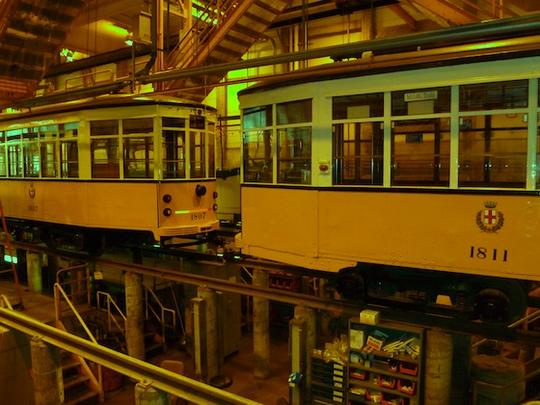SF Weekly is out with a comprehensive story on problems with Muni maintenance. The piece is written by Joe Eskanazi, who has reported incisive stories about Muni before, including this 2010 story with Greg Dewar.
The story focuses on archaic practices, especially in the procurement and installation of parts. It’s very much worth reading, and it jibes pretty closely with what we have observed over the years. It may seem shocking to some that Muni operations will apply pressure to put vehicles onto the street, knowing that they’ll break down quickly, but needing to make their statistical pull-out count.
Those of us who have been around Muni for awhile, though, know this is nothing at all new. It was common practice at least as far back as Muni’s first PCC era (which ended in 1982), when the maintenance team would shove streetcars they knew were bad runners out the door day after day, only to have them return broken down, sometimes after just a few blocks. But at least there was some excuse for that, with only 105 PCCs on the property and weekday peak demand for 100 on the street — a spare factor of just five percent, totally inadequate by any industry standard.
Today’s problems have broader causes and wider ranging effects, and the story covers some of that. There is certainly no question to those who know, however, that the parts procurement system is totally archaic and wasteful, and that the maintenance function has been starved for both human resources and parts across the board for years. It is all part of the chronic underfunding of Muni, and, as the article points out, the siphoning off of significant amounts of funding to help cover the deficits of other city agencies.
To his credit, Director of Transit John Haley did not try to cover up the problems or make excuses in the article. Indeed, as the article points out, these bad systems and poorly built buses and LRVs predated his tenure at SFMTA, as well as that of his boss, Director of Transportation Ed Reiskin. It’s our impression that both men are trying very hard to find ways to solve the problems mentioned in the article, but they are deep seated, and will not be easy to fix.
In our experience, the maintenance teams working on the historic streetcars and cable cars are dedicated and can do a spectacular job when adequate resources are available. But the streetcar maintenance crew has been running shorthanded for as long as we can remember, and no amount of overtime can really compensate for steady, ongoing maintenance, whether a vehicle is new or old. And the cable car maintenance crew recently had a painter cut from the team, making it harder to keep these symbols of the city looking as good as they should.
One observation about the story, from our perspective: the reporter writes Muni “must scour the globe to unearth pieces for aging and exotic vehicles. In addition to eBay, components for the historic trolleys have been purchased from museums.” He ties this to an observation from Haley, but doesn’t cite him as the source for the statement.
The fact is that on a few occasions, Muni has indeed procured unusual parts from museums or, once or twice at the most, from eBay (they actually bought two Pittsburgh PCCs for a pittance that way years ago, providing parts worth many times the purchase price). And most of the time, we, Market Street Railway, acted on Muni’s behalf, often at our own expense, handling all the paperwork involved in the purchase as well.
We’ve done similar things, completely above board, to help procure badly needed cable car parts, when the regular city procurement process would have taken six months (no kidding). But these few parts acquisitions represent a minuscule fraction of the parts Muni must procure, and distracts from the huge problem of seeing Breda LRVs with a total investment of around $4 million per car stripped of parts while waiting for accident repair, usually because budget skimping or archaic procedures have left a shortfall of needed parts for the rest of the LRV fleet.
Bringing the parts procurement and distribution process into even the late 20th century would be a big step forward in helping address the overall Muni maintenance problems. In our view, those problems are exacerbated by politically-driven moves to offer such things as free fares to all youth, and to start up new bus lines like the 83X, the so-called “Twitter Express,” with virtually no public process. It’s not that these aren’t laudable actions, necessarily, just that the money for them has to come from somewhere — and, as the article points out, all too often it has come at the expense of maintenance, which ends up affecting every single rider.
